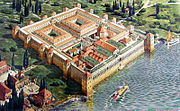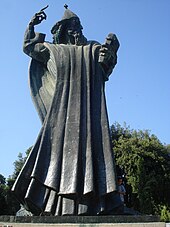See also: Timeline of Split history
For more information on the history of Split's region, see History of Dalmatia.
Antiquity[edit]
See also: Salona and Diocletian's Palace
Although the beginnings of Split are traditionally associated with the construction of Diocletian's Palace in 305 CE, the city was founded several centuries earlier as the Greek colony of Aspálathos, or Spálathos. It was a colony of the polis of Issa, the modern-day town of Vis on the island of the same name, then inhabited by Dorian Greeks. Issa, itself a colony of the Sicilian city of Syracuse, had acquired sovereignty and started founding its own colonies in 367 BCE, after the death of Dionysius the Elder.[6] The exact year the city was founded is not known, but it's estimated to have been in the 3rd or 2nd century BCE.[7]
The Greek settlement lived off trade with the surrounding Illyrian tribes, mostly the Delmatae.[6] In time, the Roman Republic became the dominant power in the region, conquering the Illyrians in the Illyrian Wars of 229 and 219 BCE. Upon establishing permanent rule, the Romansfounded the Province of Dalmatia.[8] The city of Salona, only a short distance from Spálathos, became the capital of the province and evolved into a significant city in the Roman state. The history of Spálathos becomes obscure for a while at this point, being overshadowed by that of nearby Salona, to which it would later become successor.
The Roman Emperor Diocletian (ruled 284 to 305 CE) reformed the government in the late Roman Empire and established the Tetrarchy. This new system presupposed that Diocletian himself would retire at some point in favor of Galerius. Thus, in 293 CE, he began the construction of an opulent and heavily fortified palace near his home town of Salona, selecting the site of Spálathos (or Spalatum in Latin). The palace was built directly fronting the sea, so as to allow its occupant to escape by that means if necessary (in an era plagued by civil wars). The site was most likely chosen due to being near to Salona, but also with a secure port and a more immediate access to the open sea in the case of an attack. Following a bout of illness in 303 CE, Diocletian announced he would retire as soon as his Palace, scheduled for completion in 305 CE, was ready.[9][10]
The Palace was built as a massive structure, much like a Roman military fortress. It faces the sea on its south side, with its walls 170 to 200 metres (570 to 700 feet) long, and 15 to 20 metres (50 to 70 feet) high, enclosing an area of 38,000 m² (9½ acres). The palace water supply was substantial, fed by an aqueduct from the Jadro Spring (9 km away from the city), which supplies the city to this day.[11] The palace and the city of Spalatum which formed its surroundings were at times inhabited by a population as large as 8,000 to 10,000 people.[12] Diocletian established Marjan hill as a recreational area for the residents,[13] a tradition which persists to this day. The palace was finished on schedule in AD 305. Diocletian accordingly retired, becoming the first Roman Emperor to voluntarily remove himself from office.[14] After Diocletian's death, the palace became state property and was used for various purposes.[15] For a period one part of it seems to have been the site of a textile manufactory where Salonitan women worked.[16]
The Palace was to have one further significant occupant, however: Flavius Julius Nepos, the last legitimate Emperor of the Western Roman Empire. By the late 5th century CE, the Western provinces of the Empire fell under the control of various Germanic confederations. Dalmatia (which had been considered a Western province since the reign ofTheodosius I) eventually remained the only exception in that regard. From 468 CE, the Province was ruled by Julius Nepos, who was appointed Western Emperor in 473 CE byLeo I of the Eastern Court. He attempted to establish himself in the Western capital of Ravenna (right across the Adriatic from Salona), but was deposed within two years by his Germanic Magister militum, Orestes. He returned to Salona in 475 and took Diocletian's Palace for his residence.[16] Orestes installed his young son Romulus Augustulus as the Emperor in the West, but was murdered within a year (476 CE) by Odoacer and his son deposed. Thereupon Odoacer did not establish his own puppet emperor, but instead returned the Imperial regalia of the West to the Emperor in the East (that now being Emperor Zeno), effectively abolishing the Western Imperial throne. The Eastern Court in Constantinople, however, still recognized Julius Nepos as legitimate Western Emperor.[17] From AD 475, Nepos therefore ruled from Diocletian's Palace as effective "Emperor of Dalmatia". He was however murdered in the Palace by local political enemies in 480 CE, whereupon the two thrones of the Roman Empire were formally united under the Eastern emperors in Constantinople, who now became the sole Roman emperors. The Empire itself is henceforward more commonly referred to in historiography as the Byzantine Empire. In 493 CE Salona, along with most of Dalmatia, was lost to the Ostrogothic Kingdom. However, by 535 CE the Emperor Justinian the Great was ready to attempt a reconquest of Roman lands held by the Ostrogoths. By July of the same year, the Roman general Mundus had quickly overrun Dalmatia and captured Salona. But a large Gothic army arrived to reclaim the province, and though he inflicted a heavy defeat upon them, Mundus himself was mortally wounded. As a result, the Roman army withdrew, and all of Dalmatia, with the exception of Salona, was abandoned to the Goths.[18] Salona was then taken by the Gothic general Gripas. Justinian dispatched a new general, Constantianus, to recover Dalmatia, which he accomplished speedily. Gripas was forced to abandon Salona because of the ruined state of its fortifications and the pro-Roman stance of its citizens. Constantinianus then occupied the city and rebuilt its walls. Seven days later, the Gothic army departed for Italy, so that by late June 536 CE Dalmatia was again in Roman hands.[19][20]
Sack of Salona[edit]
The history of Split as a significant city, in its own right, begins with the Sack of Salona by the Avars in 639 CE. Conflicting versions of the event are in existence, and it is unknown whether the city was taken by treachery, by ruse, or whether the defense was simply abandoned by the terrified populace. In either case, the city (in spite of its newly-rebuilt circuit of walls) fell with little or no resistance, and was thoroughly sacked and destroyed, "so that nothing but the theatre remained standing".[21] The Romans of Salona fled by sea to the nearby Adriatic islands of Solentia (Šolta), Bretia (Brač), Pharia (Hvar), Issa (Vis), and Corcyra Nigra (Korčula). The Avars had ravaged the entire region and expelled or killed most of the Roman population. The Dalmatian region and its shores were at this time settled by tribes of Croats, a South Slavic people subservient to the Avar khagans[22] (the Avars themselves, i.e. the Avar Khaganate, occupied the more fertile land of thePannonian Basin).
For the following decade, the Salonitans lived in huts on the islands, suffering from a lack of drinking water (the islands themselves appear to have been mostly deserted by that time). The younger men equipped some light ships and raided Croat settlements on the mainland "so that none of the Slavs dared to go down to the sea".[21] At this point there emerged a leader among the exiles, known only as Severus the Great ("whose house had stood next to the columns of the Palace by the sea"[21]). He persuaded the vast majority of the remaining Salonitans to return to the mainland. They could not return to the ruins of Salona, which were entirely indefensible and closer to the Slavic tribes of the interior, but chose instead to occupy the 300-year-old Palace of Diocletian. They intended to stay in the Palace until such a time as Salona might be reoccupied, but this never became possible. The strong fortifications of the palace, along with its placement directly upon the sea, meant that it could not be effectively besieged by the Slavic tribes of the mainland.[22]
The Salonitans occupied the Palace around the year 650 CE. Their numbers were so reduced by this point that the fortress-like structure, which was not built to serve as a city, was sufficient for their needs. Contrary to their expectations of retaking Salona, the citizens were hard-pressed to maintain themselves even in the Palace. Upon hearing of their return, the Croats destroyed their crops and confined them within the gates. The Emperor Constans II intervened at this point, and granted them an Imperial mandate to establish themselves in the Palace as the City of Spalatum, which imposed upon the Slavs a cessation of further hostilities through diplomatic arrangements.[22] The Empire itself at this time was hard-pressed to defend itself against the Caliphate and the Lombards in Italy, but was at the time in fact allied with the Croatian Slavs against the Avars.
The citizens of Spalatum now purged the temple of Jupiter in Diocletian's Palace and rededicated it to the Virgin Mary. They undertook a dangerous expedition to the overgrown ruins of Salona to recover the remains of the popular Saint Domnius, a one-time Bishop of Salona of Syrian ancestry, executed by order of Emperor Diocletian. They brought the remains to Spalatum in great haste, fearing attack by Slavs, and so brought the remains of the wrong saint. A second expedition was more successful, and the Cathedral of Saint Domnius could now be established with the necessary conditions of sanctity (some have later argued, however, that the remains interred in the Cathedral were not in fact those of Saint Domnius).[22] The new see was invested by the Pope with all the authority of the ancient archiepiscopal see of Salona. The Archbishop of Salona retained his status as metropolitan of all Dalmatia, continuing on to be referred to for centuries by the name of the ruined ancient city.[22] In 1100, the bell tower which became the main symbol of the city was constructed and dedicated to Saint Domnius, by then regarded as the patron saint of the city.
Byzantine period[edit]
Throughout the following centuries, effectively until the Fourth Crusade and the Sack of Constantinople, Split remained a de jure possession of theByzantine Empire. Its hinterland, however, ravaged and desolated by the Avar invasion (from which it never fully recovered), was lost to the Empire beyond much hope of recovery. The region was now home to the Duchy of the Croats. In this period, an independent Dalmatian languagedeveloped from Latin, with a distinct local dialect: to its inhabitants, the city became known as Spalatrum or Spalatro.
Dalmatia, or rather the cities, islands, and the immediate coastline, was organized as a Byzantine duchy, administered by the Exarchate of Ravenna. After the final fall of Ravenna to the Lombards in 751, the prefects and fleet fled from Ravenna to the port of Jadera (Zadar), and the Duchy of Dalmatia began to be administered from there. The cities along the coast, however, enjoyed significant privileges and in practice ran their own affairs independently.[23]
In 925, in the hinterland of Spalatro, Tomislav, Duke of the Croats, conquered the Duchy of Pannonia to the north, and the Kingdom of Croatianow emerged in the hinterland of the city. He was an ally of the Byzantine Empire against their common enemy, Simeon I of Bulgaria, and relations with the Empire were cordial. However, contrary to some claims originating in the 19th



No comments:
Post a Comment